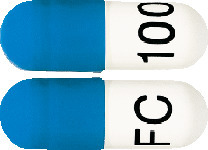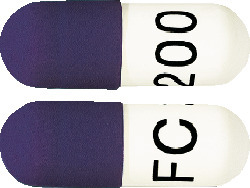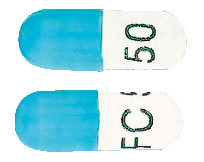SUMMARY CMI
Fluconazole Sandoz®
Consumer Medicine Information (CMI) summary
The full CMI on the next page has more details. If you are worried about using this medicine, speak to your doctor or pharmacist.
1. Why am I using Fluconazole Sandoz?
Fluconazole Sandoz contains the active ingredient fluconazole. Fluconazole Sandoz capsules is used to treat certain fungal and yeast infections.
For more information, see Section 1. Why am I using Fluconazole Sandoz? in the full CMI.
2. What should I know before I use Fluconazole Sandoz?
Do not start treatment if you have ever had an allergic reaction to fluconazole, or any of the ingredients listed at the end of the CMI or any other similar medicines such as miconazole, ketoconazole or clotrimazole.
Tell your doctor if you have had any allergic reaction to any antifungal, or any foods, preservatives or dyes or any other medicines. Talk to your doctor if you have any other medical conditions, take any other medicines, or are pregnant or plan to become pregnant or are breastfeeding.
You must not be given Fluconazole Sandoz if you are taking certain medicines. For more information, see Section 2. What should I know before I use Fluconazole Sandoz? in the full CMI.
3. What if I am taking other medicines?
Some medicines may interfere with Fluconazole Sandoz and affect how it works. A list of these medicines is in Section 3. What if I am taking other medicines? in the full CMI.
4. How do I use Fluconazole Sandoz?
- Swallow Fluconazole Sandoz capsules whole with water.
- Your doctor will decide how much Fluconazole Sandoz will be given to you each day and for how long. It will depend on your condition and other factors. More instructions can be found in Section 4. How do I use Fluconazole Sandoz? in the full CMI.
5. What should I know while using Fluconazole Sandoz?
| Things you should do |
|
| Things you should not do |
|
| Looking after your medicine |
|
For more information, see Section 5. What should I know while using Fluconazole Sandoz? in the full CMI.
6. Are there any side effects?
Fluconazole Sandoz is generally well tolerated. Side effects may include nausea, vomiting, abdominal pain, diarrhoea, headache, skin rash or redness and easy bruising of the skin, seizures, signs of frequent or worrying infections such as fever, severe chills, sore throat or mouth ulcers, or change in liver function.
For more information, including what to do if you have any side effects, see Section 6. Are there any side effects? in the full CMI.
FULL CMI
Fluconazole Sandoz®
Active ingredient(s): fluconazole (flu-con-a-zole)
Consumer Medicine Information (CMI)
This leaflet provides important information about using Fluconazole Sandoz. You should also speak to your doctor or pharmacist if you would like further information or if you have any concerns or questions about using Fluconazole Sandoz.
Where to find information in this leaflet:
1. Why am I using Fluconazole Sandoz?
2. What should I know before I use Fluconazole Sandoz?
3. What if I am taking other medicines?
4. How do I use Fluconazole Sandoz?
5. What should I know while using Fluconazole Sandoz?
6. Are there any side effects?
7. Product details
1. Why am I using Fluconazole Sandoz?
Fluconazole Sandoz contains the active ingredient fluconazole. Fluconazole Sandoz is used to treat certain fungal and yeast infections.
Fluconazole Sandoz belongs to a group of medicines called azole antibiotics.
It works by preventing the growth of the fungal and yeast organisms causing your infection.
Ask your doctor if you have any questions about why Fluconazole Sandoz has been prescribed for you.
Your doctor may have prescribed it for another reason.
Fluconazole Sandoz is available only with a doctor's prescription.
This medicine is not addictive.
2. What should I know before I use Fluconazole Sandoz?
Warnings
Do not start treatment with Fluconazole Sandoz if:
- you are allergic to fluconazole, or any of the ingredients listed at the end of this leaflet, or any medicines related to fluconazole such as miconazole, ketoconazole or clotrimazole. Always check the ingredients to make sure you can use this medicine.
- Symptoms of an allergic reaction include
- shortness of breath
- wheezing or difficulty breathing
- swelling of the face, lips, tongue or other parts of the body
- skin rash, itching or hives
You must not be given Fluconazole Sandoz if you are taking any of the following medicines:
- terfinadine or astemizole (a medicine used to treat allergy)
- cisapride (a medicine used to treat stomach problems)
- erythromycin (a medicine used to treat infections)
- pimozide (a medicine used to treat mental illness)
- quinidine (a medicine used to treat irregular heartbeat).
Check with your doctor if you:
- have allergies to any foods, preservatives or dyes or any other medicines
- are taking medicines for any other condition
- have any other medical conditions
- have liver problems
- have heart problems
- have kidney problems
Your doctor may need to monitor the function of the liver using blood tests. Be sure to follow the doctor's advice if regular checks on your/ your child's liver are recommended.
During treatment, you may be at risk of developing certain side effects. It is important you understand these risks and how to monitor for them. See additional information under Section 6. Are there any side effects?
Pregnancy and breastfeeding
Check with your doctor if you are pregnant or intend to become pregnant.
Fluconazole Sandoz use should be avoided during pregnancy except on doctor's advice for severe or life-threatening infections. Effective contraception should be used in women of childbearing potential and should continue throughout the treatment period and for approximately 1 week after the final dose. Your doctor can discuss with you the risks and benefits involved.
Talk to your doctor about the need for an additional method of contraception while being given Fluconazole Sandoz.
Fluconazole Sandoz may decrease the effectiveness of some birth control pills.
Talk to your doctor if you are breastfeeding or intend to breastfeed.
Fluconazole Sandoz is not recommended for use whilst breastfeeding however your doctor can discuss with you the risks and benefits involved.
3. What if I am taking other medicines?
Tell your doctor or pharmacist if you are taking any other medicines, including any medicines, vitamins or supplements that you buy without a prescription from your pharmacy, supermarket or health food shop.
Some medicines should not be taken with Fluconazole Sandoz.
These are listed under Section 2. What should I know before treatment with Fluconazole Sandoz.
Some medicines and Fluconazole Sandoz may interfere with each other. These medicines and some others may be affected by Fluconazole Sandoz and affect how it works. You may need different amounts of your medicines, or you may need to take different medicines. These include:
- some medicines for diabetes such as glipizide, tolbutamide or glibenclamide
- some antibiotics, antiviral and antifungal drugs such as rifampicin, rifabutin, zidovudine, amphotericin B, azithromycin, saquinavir or voriconazole
- some drugs used for heart problems, such as amiodarone or verapamil
- some drugs used in problems with the immune system, such as ciclosporin, tacrolimus, sirolimus or tofacitinib
- some medicines used to lower cholesterol, such as atorvastatin, simvastatin or fluvastatin
- cyclophosphamide, vincristine, vinblastine, olaparib or ibrutinib (used to treat certain types of cancers)
- tolvaptan (used to treat low levels of sodium in your blood or for kidney problems)
- halofantrine (used to treat malaria)
- warfarin (used to stop blood clots)
- phenytoin (used to treat epilepsy)
- prednisone (used to treat inflammation or suppress the immune system)
- theophylline (used to treat asthma)
- some benzodiazepines such as midazolam
- lemborexant (used to treat insomnia or sleeping difficulties)
- ivacaftor (used to manage cystic fibrosis)
- lurasidone (used to manage schizophrenia)
- hydrochlorothiazide (used for treating fluid problems)
- the contraceptive pill (birth control pill)
- carbamazepine (used in the treatment of epilepsy and bipolar disorder)
- NSAIDS such as naproxen, diclofenac and celecoxib
- Vitamin A
- opioid pain killers such as alfentanil, fentanyl and methadone
- losartan (used for treating high blood pressure)
- antidepressants such as amitriptyline and nortriptyline.
Check with your doctor or pharmacist if you are not sure about what medicines, vitamins or supplements you are taking and if these affect Fluconazole Sandoz.
4. How do I use Fluconazole Sandoz?
How much to take
Adults
- The dose will depend on your infection and how you respond to Fluconazole Sandoz. It usually ranges from 50 mg to 400 mg once daily.
Children
- The dose for a child will depend on body weight and usually ranges from 3 mg to 12 mg per kilogram of body weight.
However, depending on how serious the infection is, and how you react to this medicine, your doctor may ask you to take a different dose.
When to take Fluconazole Sandoz
- Try to take your medicine at about the same time each day.
Taking it at the same time each day will have the best effect. It will also help you to remember when to take it. - It does not matter if you take this medicine before or after food.
How to take Fluconazole Sandoz
- Swallow the capsules whole with water.
How to long to take Fluconazole Sandoz
- Continue taking Fluconazole Sandoz until you finish the pack or until your doctor recommends.
- The length of time you take Fluconazole Sandoz will depend on the sort of infection you have.
- Patients with a weakened immune system or those with difficult infections may need long-term treatment to prevent the infection from returning.
- Do not stop taking your Fluconazole Sandoz because you are feeling better.
- If you do not complete the full course prescribed by your doctor, the infection may not clear completely or your symptoms may return.
If you forget to use Fluconazole Sandoz
Fluconazole Sandoz should be used as prescribed. If you miss your dose at the usual time, please see the following instructions.
If it is almost time for your next dose, skip the dose you missed and take your next dose when you are meant to.
Do not take a double dose to make up for the dose you missed.
Otherwise, take it as soon as you remember, then go back to take it as you would normally.
If you use too much Fluconazole Sandoz
If you think that you have used too much Fluconazole Sandoz, you may need urgent medical attention.
You should immediately:
- phone the Poisons Information Centre
(by calling 13 11 26), or - contact your doctor, or
- go to the Emergency Department at your nearest hospital.
You should do this even if there are no signs of discomfort or poisoning.
5. What should I know while using Fluconazole Sandoz?
Things you should do
- If you are a woman of child-bearing age, you should avoid becoming pregnant while taking Fluconazole Sandoz. Talk to your doctor about the need for an additional method of contraception while being given Fluconazole Sandoz. If you do become pregnant while taking Fluconazole Sandoz, tell your doctor immediately.
- If you suffer from HIV or have a weakened immune system and develop a rash while taking Fluconazole Sandoz, tell your doctor immediately. If this rash worsens, Fluconazole Sandoz may need to be stopped.
- Be sure to follow your doctor's advice if regular checks on your liver are recommended. In rare cases, Fluconazole Sandoz may affect the liver and may need to be stopped.
- If the symptoms of your infection do not improve within a few days, or if they become worse, tell your doctor.
- Remind any doctor, dentist, or pharmacist you visit that you are using Fluconazole Sandoz.
Things you should not do
- Do not start treatment if you have ever had an allergic reaction to any medicine containing fluconazole, any of the ingredients listed at the end of this CMI
- Do not stop taking Fluconazole Sandoz or lower the dosage without checking with your doctor.
If you do not complete the full course prescribed by your doctor, all of the organisms causing your infection may not be killed. These organisms may continue to grow and multiply so that your infection may not clear completely or may return. - Do not give your medicine to anyone else, even if they have the same condition as you.
- Do not use Fluconazole Sandoz to treat any other medical complaints unless your doctor tells you to.
Driving or using machines
Be careful when driving vehicles or operating machinery as occasional dizziness or seizures may occur.
Drinking alcohol
No information available.
Looking after your medicine
- Keep your medicine in its original pack until it is time to take it.
- If you take it our of the pack it may not keep well.
Store it in a cool dry place below 25°C away from moisture, heat or sunlight; for example, do not store it:
- in the bathroom or near a sink, or
- in the car or on window sills.
Keep it where young children cannot reach it.
Getting rid of any unwanted medicine
If you no longer need to use this medicine or it is out of date, take it to any pharmacy for safe disposal.
Do not use this medicine after the expiry date.
6. Are there any side effects?
All medicines can have side effects. If you do experience any side effects, most of them are minor and temporary. However, some side effects may need medical attention.
See the information below and, if you need to, ask your doctor or pharmacist if you have any further questions about side effects.
Less serious side effects
| Less serious side effects | What to do |
Gut or Gastrointestinal related
| Speak to your doctor if you have any of these less serious side effects and they worry you. |
Serious side effects
| Serious side effects | What to do |
Allergy or reaction related
| Call your doctor straight away, or go straight to the Emergency Department at your nearest hospital if you notice any of these serious side effects. |
Tell your doctor or pharmacist if you notice anything else that may be making you feel unwell.
Other side effects not listed here may occur in some people.
Reporting side effects
After you have received medical advice for any side effects you experience, you can report side effects to the Therapeutic Goods Administration online at www.tga.gov.au/reporting-problems. By reporting side effects, you can help provide more information on the safety of this medicine.
Always make sure you speak to your doctor or pharmacist before you decide to stop taking any of your medicines.
7. Product details
This medicine is only available with a doctor's prescription.
What Fluconazole Sandoz contains
| Active ingredient (main ingredient) | fluconazole |
| Other ingredients (inactive ingredients) |
|
| Potential allergens |
|
Do not take this medicine if you are allergic to any of these ingredients.
What Fluconazole Sandoz looks like
Fluconazole Sandoz 50 mg – Hard gelatin capsules with a turquoise cap and white body, marked with FC50
(AUST R 104285).
Fluconazole Sandoz 100 mg – Hard gelatin capsules with a blue cap and white body, marked with FC100
(AUST R 104288).
Fluconazole Sandoz 200 mg – Hard gelatin capsules with a purple cap and white body, marked with FC200
(AUST R 104293).
Available in blister packs of 28 capsules.
Who distributes Fluconazole Sandoz
Sandoz Pty Ltd
ABN 60 075 449 553
54 Waterloo Road
Macquarie Park, NSW 2113
Tel: 1800 726 369
Novartis New Zealand Ltd
PO Box 99102
Newmarket, Auckland 1149
New Zealand
Tel: 0800 354 335
This leaflet was revised in October 2022.
Published by MIMS November 2022




 For patients receiving regular dialysis, administer one recommended dose after every dialysis session.
For patients receiving regular dialysis, administer one recommended dose after every dialysis session.





 Clearance corrected for bodyweight was not affected by age in these studies. Mean body clearance in adults is reported to be 0.23 mL/minute/kg.
Clearance corrected for bodyweight was not affected by age in these studies. Mean body clearance in adults is reported to be 0.23 mL/minute/kg. Chemical name: 2-(2,4-difluorophenyl)-1,3-bis(1H-1,2,4-triazol-1-yl)-2-propanol.
Chemical name: 2-(2,4-difluorophenyl)-1,3-bis(1H-1,2,4-triazol-1-yl)-2-propanol.